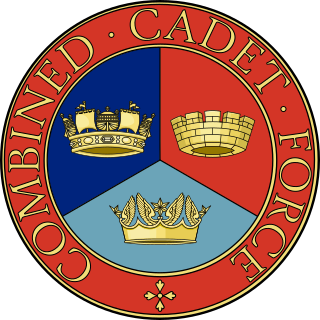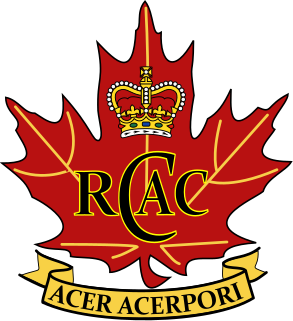This article includes a list of references, related reading or external links, but its sources remain unclear because it lacks inline citations .(August 2014) |
This article includes a list of references, related reading or external links, but its sources remain unclear because it lacks inline citations .(August 2014) |
Certificate "A" was a military proficiency award originally used by the university cadet corps. It was associated initially with a more advanced Certificate "B", the holding of which, gave entry into the Special Reserve of Officers or the Territorial Force as an officer. Certificate "A" was at the level of basic training. The certificates were recognized by the War Office in 1908. This was extended to other cadet corps during the Great War (1914–18). These cadet corps were mainly in secondary and public schools, until 1942 when the Army Cadet Force came into being. By the middle of the 1930s, Certificate "A" was the aim of every new cadet. In 1990 the Army Cadet Force Implemented the Army Proficiency Certificate or APC syllabus which overhauled the activities which the cadets undertook including dropping the requirement for some modules such as hand-to-hand combat. The APC syllabus covered subjects such as: Skill at Arms , Fieldcraft and First aid.
To obtain the certificate, both military and fitness tests had to be passed. In 1942, the military test consisted of:
The fitness tests varied according to local facilities, but included running; rope work,; wall climbing; an endurance test; water ability (either swimming or treading water). Some units had more tests but these were not listed on the reverse of the certificate.
The certificate award was often made at a parade of the cadet's unit and consisted of the certificate and a four-pointed star with a red centre to be sewn on the lower sleeve. During World War II, having the award reduced the time of preliminary training after conscription call-up, and was said to be a help in advancing to become a NCO.

The Combined Cadet Force (CCF) is a youth organisation in the United Kingdom, sponsored by the Ministry of Defence (MOD), which operates in schools, and normally includes Army, Royal Navy and Royal Air Force sections. Its aim is to "provide a disciplined organisation in a school so that pupils may develop powers of leadership by means of training to promote the qualities of responsibility, self reliance, resourcefulness, endurance and perseverance".
The Officers' Training Corps (OTC), more fully called the University Officers' Training Corps (UOTC), are military leadership training units operated by the British Army. Their focus is to develop the leadership abilities of their members whilst giving them an opportunity to take part in military life whilst at university. OTCs also organise non-military outdoor pursuits such as hill walking and mountaineering. UOTC units are not deployable units nor are their cadets classed as trained soldiers. The majority of members of the UOTC do not go on to serve in the regular or reserve forces.

The Air Training Corps (ATC) is a British volunteer-military youth organisation. They are sponsored by the Ministry of Defence and the Royal Air Force. The majority of staff are volunteers, and some are paid for full-time work – including Commandant Air Cadets, a Full Term Reserve Service RAF officer. Although many ATC cadets go on to join the RAF or other services, the ATC is not a recruiting organisation for its parent service.

The Army Cadet Force (ACF), generally shortened to Army Cadets, is a national youth organisation sponsored by the United Kingdom's Ministry of Defence and the British Army. Along with the Sea Cadet Corps and the Air Training Corps, the ACF make up the Community Cadet Forces. It is a separate organisation from the Combined Cadet Force which provides similar training within principally independent schools.

The Army Reserve (AR) is the reserve land component of the Irish Defence Forces. It is the second line reserve of the Irish Army. The Army Reserve involves active military service on a part-time basis, and is one of two elements of the Reserve Defence Forces, the other element being the Naval Service Reserve (NSR).

The Royal Canadian Army Cadets is a national Canadian youth program sponsored by the Canadian Armed Forces and the civilian Army Cadet League of Canada. Under the authority of the National Defence Act, the program is administered by the Canadian Armed Forces and funded through the Department of National Defence. Additionally, the civilian partner of the Royal Canadian Army Cadets, the Army Cadet League of Canada, also ensures financial, accommodations and transportation support for RCAC programs and services at a community level.
King William's College is an independent school for pupils aged 3 to 18, located near Castletown on the Isle of Man. It is a member of the International Baccalaureate and Headmasters' and Headmistresses' Conference organisations. The College operates at two sites in or near Castletown: a main senior school campus on the shore of Castletown Bay, and a prep school in the Westhill part of Castletown, two miles from the main campus. The College was originally for boys only, but became co-educational in the 1980s. It has roughly five hundred pupils, many from beyond the British Isles.

The National Cadet Corps (NCC) is the youth wing of the Indian Armed Forces with its headquarters in New Delhi, India. It is open to school and college students on voluntary basis as a Tri-Services Organisation, comprising the Army, the Navy and the Air Force, engaged in developing the youth of the country into disciplined and patriotic citizens. The soldier youth foundation in India is a voluntary organization which recruits cadets from high schools, higher secondary, colleges and universities all over India. The cadets are given basic military training in small arms and drill. The officers and cadets have no liability for active military service once they complete their course.

The Cayman Islands Cadet Corps (CICC) is a youth organisation in the Cayman Islands for male and female secondary school students between age 12 and 17. It was established in March 2002.
The Royal Air Force Volunteer Reserve (RAFVR) was established in 1936 to support the preparedness of the U.K. Royal Air Force in the event of another war. The Air Ministry intended it to form a supplement to the Royal Auxiliary Air Force (RAuxAF), the active reserve for the RAF, by providing an additional non-active reserve. However during the Second World War the high demand for aircrew absorbed all available RAuxAF personnel and led the RAFVR to quickly become the main pathway of aircrew entry into the RAF. It was initially composed of civilians recruited from neighbourhood reserve flying schools, run by civilian contractors with largely RAF-trained flying instructors as well as other instructors in related air war functions, such as observers and wireless operators.
Selection and training in the British Army is the process by which candidates for service are identified, inducted and brought onto the trained strength. The process is the responsibility of the Adjutant General, the personnel director for the Army based at Trenchard Lines in Wiltshire.

The University of Oklahoma Army ROTC is the primary officer training and commissioning program at the University of Oklahoma and one of the oldest in the nation, having existed in some form since the First World War. It is known as the "Sooner Battalion" and is notable for having produced thousands of officers for the United States Army, including 19 general officers. It is led by three officers and two noncommissioned officers.

The Lebanese Army Military Academy is a part of the Lebanese Armed Forces. The academy is situated at Shikri Ghanem military base, Faiyadiyeh, Baabda District, and is attached administratively to the command and administration department. It is one of the oldest military institutions in Lebanon, and was founded in Damascus in 1921 under the French mandate.
Within the framework of the training programme Air Training Corps cadets have the opportunity of taking part in many activities. On most Squadrons the only compulsory activities in the ATC year are attendance at various church parades, usually ATC Sunday and Remembrance Sunday. Many wings also insist that attending Wing Parade is compulsory.

The Army Reserve Officers' Training Corps (AROTC) is the United States Army component of the Reserve Officers' Training Corps. It is the largest Reserve Officers' Training Corps (ROTC) program which is a group of college and university-based officer training programs for training commissioned officers for the United States Army and its reserves components: the Army Reserves and the Army National Guard. There are 30,000+ Army ROTC cadets enrolled in 274 ROTC programs at major universities throughout the United States.

The National Cadet Corps (NCC) is a military cadet corps youth organisation supported by the Ministry of Defence and the Ministry of Education. As of 2020, it had a total strength of more than 11,000 members, consisting of officers, cadet officers, and cadets, amongst others. The Corps is represented in 125 secondary schools with a total of 146 units – 108 Land units, 20 Air units and 18 Sea units.

The South African Army Training Formation is the controlling entity of all South African Army training units. The Formation was established in April 1999 and mandated to provide, maintain and sustain landward common training to the SA Army.

The Junior Reserve Officers' Training Corps is a federal program sponsored by the United States Armed Forces in high schools and also in some middle schools across the United States and at US military bases across the world. The program was originally created as part of the National Defense Act of 1916 and later expanded under the 1964 ROTC Vitalization Act.
Air Force Junior Reserve Officer Training Corps (AFJROTC) is a subdivision of the Junior Reserve Officer Training Corps (JROTC). JROTC is a junior military science elective class that is offered in many high schools across the United States. The class is the high school version of the college ROTC. The Air Force division of JROTC is composed of physical training, aerospace science academic classes, and leadership skill creation. Outside of the formal class, there are extra-curricular teams that cadets may participate in to create qualities of leadership and followership. Unlike the collegiate version of ROTC, upon completion of JROTC there is no military service required. This allows the youth of the United States to experience the military without having long-term commitments.